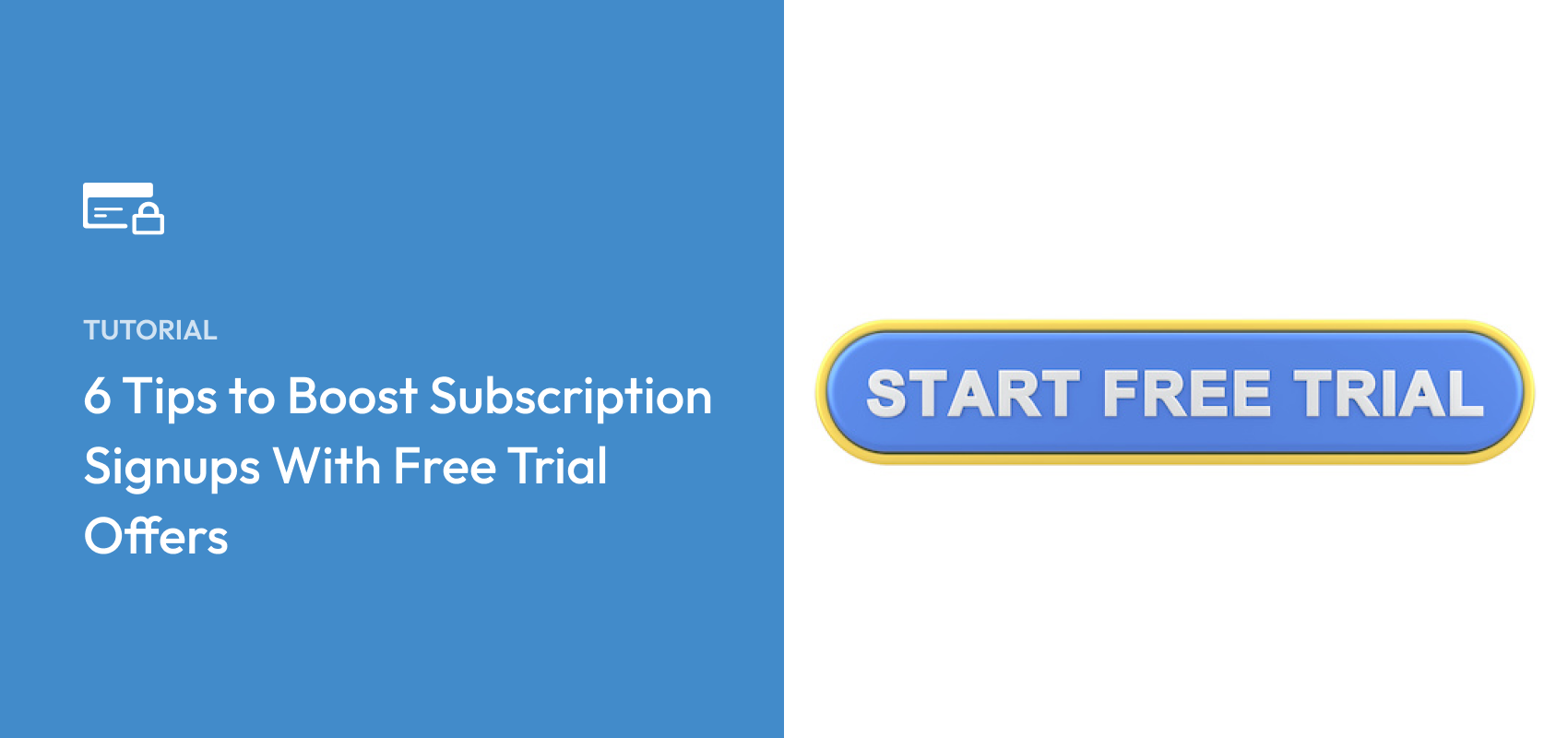6 Tips to Boost Subscription Signups With Free Trial Offers
Last updated on
Wondering how you can easily improve engagement with potential customers, receive more feedback regarding your products and services, and grow your subscriber base using free trial offers?
Whether your business provides online course memberships, paid content, subscription services, or access to digital products, you should be considering free trial periods.
In this article, we’ll share six tips regarding free trial offers that you can apply to your business model.
Why Offer a Free Trial for Subscriptions?
Consumers have grown to expect a free trial period before committing to an automatic renewal payment plan. Allowing them to get a glimpse of what you have to offer can make them feel more comfortable signing up once the free trial period has ended.
According to a recent study, 80% of online subscribers obtained their subscription via a free trial.
While the main objective behind free trials is to eventually get those who sign up for one to become long-lasting subscribers and loyal customers, they can also help you improve your products and services through feedback.
Let’s say a potential customer signs up for a free trial period and decides to cancel before they’re charged. Simply asking them a few questions about their experience can determine why you didn’t meet their expectations. Or, perhaps the cost of your products or services doesn’t fit their budget.
Is a Free Trial and Subscription Right for You?
Of course, before you begin offering free trial periods, you’ll first need to decide if a subscription-based model is right your online business.
If your products or services are something people will want to pay for repeatedly, then offering subscription plans is a great way to retain customers and generate a steady flow of income.
For example, if you have created an online course, offer software, or provide access to paid content through a membership site, you can reasonably sell these as a subscription service.
However, asking customers to pay monthly for a buy-once product or service wouldn’t make sense. You wouldn’t want to offer a subscription or a free trial if your business provides something like a logo design service. Businesses only need one logo.
With all that being said, don’t hesitate to transform your products and services into something that can be sold as a subscription service. For instance, if your marketing agency offers business logo creation in addition to web design and content marketing services, you have the opportunity to sell subscription-based plans for those recurring services.
Now, let’s take a look at six tips you can use to boost conversions and gain more subscribers using free trials.
1. Build Your Free Trial to Convert
It’s smart to use your free trial to walk your user to whatever point makes them comfortable paying for the product or service on a recurring basis.
What is that point? It’s obviously different for each product or service and the customer’s needs, but you can identify that point by determining what your users consider valuable.
Your next step is to design your free trial to drive your customer down a path to that moment of value. Once they realize the value of your product or service, there’s a good chance they’ll buy it. However, if they never realize that value, they’ll cancel before the trial period ends.
For example, let’s say you have a software tool that schedules social media posts. Your users sign up, naturally, to schedule their social media posts for them. Instead of leaving them hanging at the dashboard, your free trial should include an onboarding process that helps them schedule social media posts. That way, you’re showing them the value you provide.
This is also an important strategy to build customer loyalty over time.
If you use WP Simple Pay, the best Stripe payments plugin for WordPress that allows you to easily accept online payments without setting up a shopping cart, you can customize your email confirmation message, as well as your free trial confirmation page message, to explain when the free trial ends, how much and when the customer will be charged, and also include instructions or a link to next steps regarding how to use the service.
Below is an example of a message you can send your customers about onboarding steps:
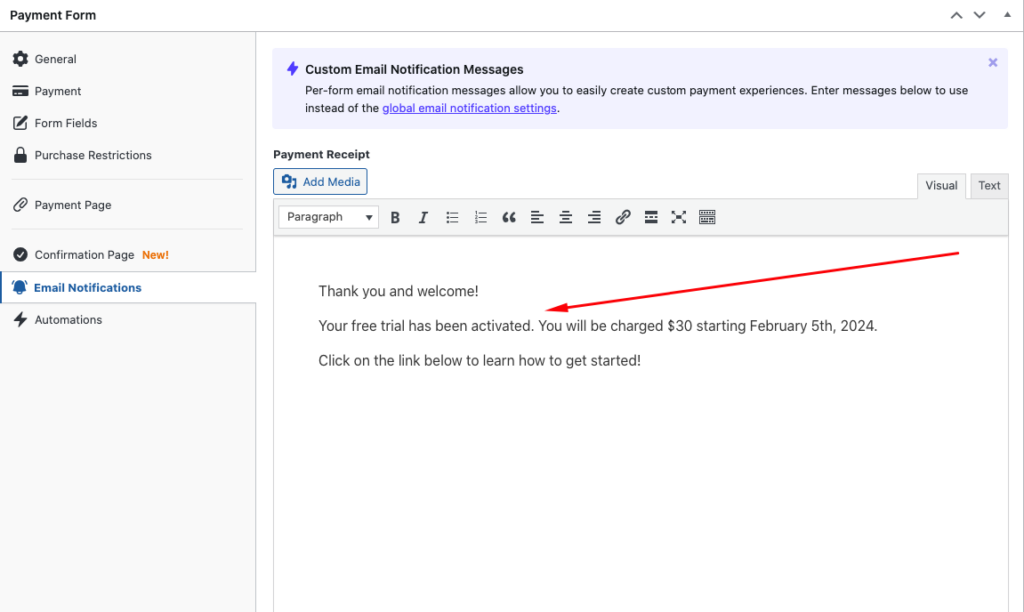
2. Limit Your Free Trial Offer Duration
There’s no precise free trial duration that applies to every product or service.
Some simple products or services can get away with offering three- or five-day trials because the user only needs a few minutes to decide if they’ll sign up. Other products need to give out extended free trials for users to adopt the system.
Generally speaking, it’s best to keep your free trial under a month. That’s usually enough time for potential customers to decide if they’ll become actual customers. Keeping the trial under a month also encourages the user to try it and make his or her decision soon.
With all that being said, don’t stick with a month because it’s what everyone else is doing. Experiment with free trial lengths to see which one converts the most customers.
WP Simple Pay makes it super easy to customize the duration of your free trial periods using the advanced drag & drop form builder.
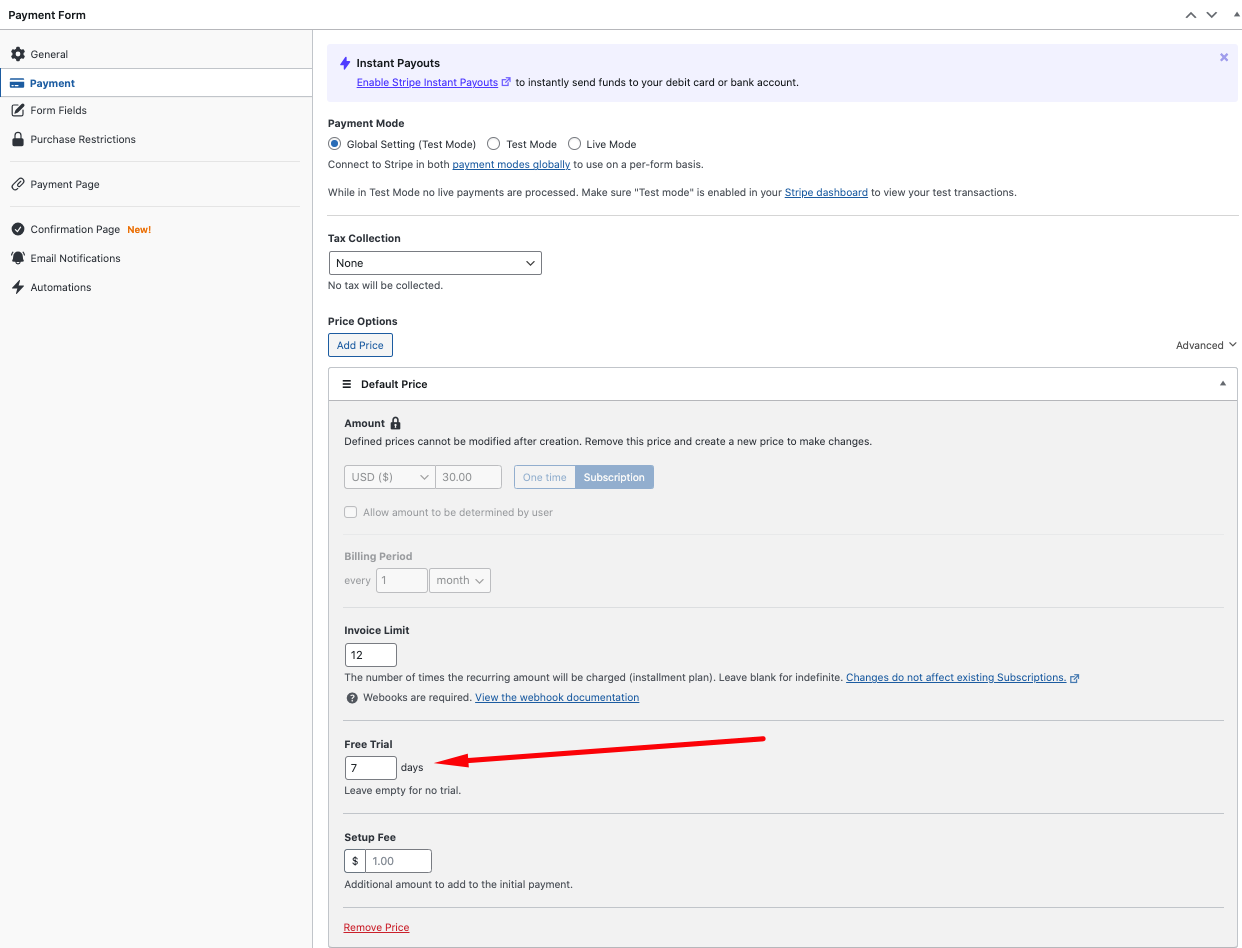
You can also use the plugin to add a setup fee that will charge the subscriber a smaller amount up front before the initial recurring payment. This fee can be used to offset the cost of offering a free trial period.
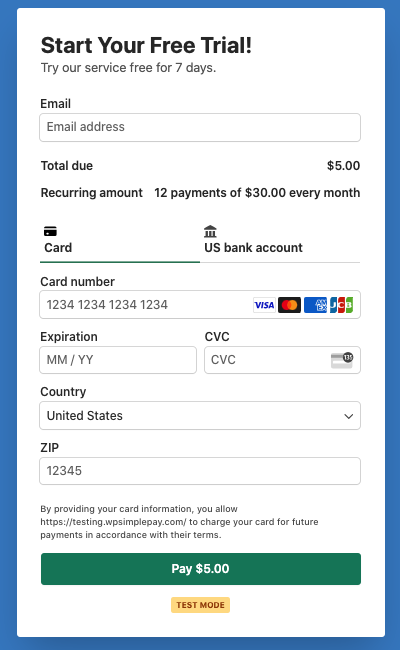
3. Place Limits on Free Trials
Besides giving users unlimited access to your services for a limited duration, another way to offer an effective free trial is to let people use a limited version of your product for an unlimited time.
In fact, here at WP Simple Pay, we offer a free lite version of our WordPress plugin that lets users accept several payment methods on their site.
If you offer digital products or have a membership site that provides valuable content on a regular basis, you can place access limits for your free subscribers that encourage them to eventually sign up for full access to paid content.
Here are a few different ways to place limits on your product or service.
- Feature Limit – Disable features or functions for free accounts.
- Usage Limit – Limit how many actions users can take (e.g., emails they send, payments they process, times they log in).
- Capacity Limit – Caps on how much information they can store (100 contacts, 2000 records, 1 TB of storage, 5 downloads).
- Output Limit – Limit or reduce what they create with your product so it can’t be used fully (a watermark on produced images and license restrictions are just a couple of examples).
What’s right for your products or services can be a mix of some of those limitations or something entirely different. Don’t feel locked into the “30 days free” model.
4. Divide Your Customers Into Segments
Even if your product or service inhabits a small industry or tiny niche, you still probably have multiple customer segments. Each segment has its own problems, needs, and preferences for a product or service like yours.
The purpose of your free trial is to help your users realize the value of your product. Think about how you can show that your product is improving your customers’ lives. It’s a good idea to design different versions of your free trial that appeal to each customer segment. That way, you can make sure each customer achieves what they find valuable.
How do you break customers into segments? It’s as simple as adding one extra field to your subscription payment form. Alternatively, you can create a branching onboarding process where the first step asks the user in a straightforward way how they intend to use the product.
For instance, you might add a field to your payment form that asks for their company size. Depending on their answer, you could funnel them into a different onboarding process so your free trial meets their needs.
WP Simple Pay allows you to easily add customized fields to your subscription payment forms. You can collect the information you need using dropdowns, text fields, and checkboxes.
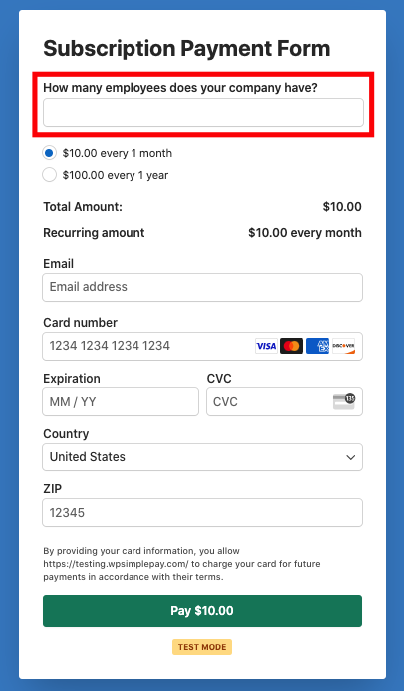
This is especially important if your product or service has many features or solves many problems. Without segmenting your users, there’s a good chance your onboarding process wouldn’t show the value you can create for them.
5. Ask for the Sale Early and Often
Many businesses make the mistake of waiting until the very end of the free trial to ask the user to purchase the product or service. Remember, you don’t owe them the entire free trial duration. It’s fine to ask for a sale as soon as you think you can get it!
The purpose of a free trial is to deliver the user to the moment they first realize value with the product. That moment is the best time to ask for the sale, regardless of how long it took to get there.
For instance, let’s say you have a customer relationship management tool that helps users close deals, and you define the first moment of value as the first time the user moves a deal from the “open” column to the “closed” column. This is the perfect time to ask them to buy.
Additionally, asking for the sale early gives you the opportunity to figure out why they won’t buy. If they refuse to buy, you can ask them why before the free trial is over. If you wait until the end of the free trial to collect feedback, there’s a good chance they will just move on from your product or service.
6. Engage and Follow Up During Free Trial
If your customer is using your product’s free trial, there’s a good chance you aren’t the most important thing happening in their life. Oftentimes, people forget about their trial and let the time expire.
You need to reach beyond your product and create additional touchpoints with your users to remind them that you exist.
This could be as simple as sending a sequence of emails with deep links that push them along the onboarding process. If, for instance, they don’t engage with a particular feature within the first three days of the trial, send them an email prompting them to check it out. You might also reach out to them personally by email to introduce them to the feature.
You can also send them emails with helpful tutorials and additional ways to use your products or services.
There you have it! We hope this article has helped you learn how to offer free trials to gain more subscribers and ultimately drive more conversions on your WordPress site.
If you liked this article, you might also want to check out our guide on how to resolve failed recurring payments.
What are you waiting for? Get started with WP Simple Pay today!
To read more articles like this, follow us on X.
Disclosure: Our content is reader-supported. This means if you click on some of our links, then we may earn a commission. We only recommend products that we believe will add value to our readers.
